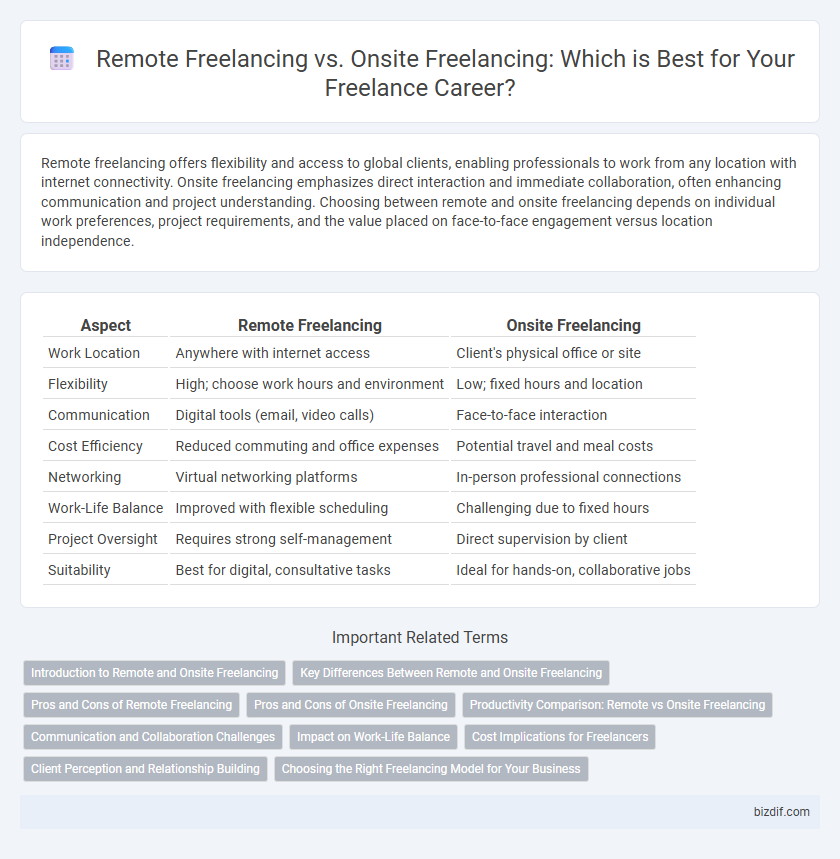Remote freelancing offers flexibility and access to global clients, enabling professionals to work from any location with internet connectivity. Onsite freelancing emphasizes direct interaction and immediate collaboration, often enhancing communication and project understanding. Choosing between remote and onsite freelancing depends on individual work preferences, project requirements, and the value placed on face-to-face engagement versus location independence.
Table of Comparison
| Aspect | Remote Freelancing | Onsite Freelancing |
|---|---|---|
| Work Location | Anywhere with internet access | Client's physical office or site |
| Flexibility | High; choose work hours and environment | Low; fixed hours and location |
| Communication | Digital tools (email, video calls) | Face-to-face interaction |
| Cost Efficiency | Reduced commuting and office expenses | Potential travel and meal costs |
| Networking | Virtual networking platforms | In-person professional connections |
| Work-Life Balance | Improved with flexible scheduling | Challenging due to fixed hours |
| Project Oversight | Requires strong self-management | Direct supervision by client |
| Suitability | Best for digital, consultative tasks | Ideal for hands-on, collaborative jobs |
Introduction to Remote and Onsite Freelancing
Remote freelancing allows professionals to work from any location using digital communication tools, providing flexibility and access to a global client base. Onsite freelancing requires freelancers to be physically present at the client's location, offering direct interaction and immediate access to resources. Both models cater to different project needs, with remote freelancing emphasizing autonomy and onsite freelancing emphasizing collaboration and hands-on involvement.
Key Differences Between Remote and Onsite Freelancing
Remote freelancing offers flexibility in work location and hours, enabling freelancers to collaborate with global clients without geographical limitations. Onsite freelancing requires physical presence at the client's location, promoting direct communication and immediate access to resources. Key differences include work environment, communication methods, and the scope of networking opportunities, impacting productivity and project management styles.
Pros and Cons of Remote Freelancing
Remote freelancing offers flexibility in work hours and location, enabling better work-life balance and access to a global client base. However, it may result in challenges such as communication barriers, distractions at home, and feelings of isolation compared to onsite freelancing. Reliable internet connection and self-discipline are crucial for maintaining productivity in remote freelance work.
Pros and Cons of Onsite Freelancing
Onsite freelancing offers direct client interaction, fostering stronger relationships and immediate feedback, which can enhance project quality and client satisfaction. However, it often requires commuting, increasing time and expense, and limits flexibility compared to remote freelancing. The structured environment of onsite work may improve focus but can reduce the freedom to set personalized work hours.
Productivity Comparison: Remote vs Onsite Freelancing
Remote freelancing often enhances productivity by minimizing commute time and offering a customizable work environment tailored to individual preferences. Onsite freelancing provides structured routines and immediate access to resources and team collaboration, which can improve focus and efficiency for certain tasks. Studies indicate that productivity varies based on industry and personal work habits, with remote freelancers reporting higher overall job satisfaction linked to flexible schedules.
Communication and Collaboration Challenges
Remote freelancing often faces communication hurdles due to time zone differences and reliance on digital tools, which can delay feedback and reduce spontaneity in collaboration. Onsite freelancing benefits from face-to-face interactions, enabling immediate clarification and stronger team dynamics, but may involve less flexibility. Effective use of project management software and regular virtual meetings can mitigate some remote communication challenges while maintaining productivity.
Impact on Work-Life Balance
Remote freelancing provides greater flexibility, enabling professionals to tailor their work schedules around personal life, thereby significantly enhancing work-life balance. Onsite freelancing often involves fixed hours and commuting, which can increase stress and reduce personal time. Studies show remote freelancers report higher satisfaction due to reduced travel and the ability to create a personalized work environment.
Cost Implications for Freelancers
Remote freelancing minimizes costs by eliminating daily commuting expenses, reducing the need for professional wardrobe purchases, and offering flexibility to work from lower-cost locations. Onsite freelancing often incurs higher travel expenses, potential relocation costs, and additional time spent outside of billable hours, increasing the overall financial burden. Understanding these cost implications helps freelancers optimize their budget and maximize net earnings effectively.
Client Perception and Relationship Building
Remote freelancing allows clients to access a global talent pool, often valuing flexibility and cost-efficiency, but may raise concerns about communication and accountability. Onsite freelancing fosters direct interaction, enhancing trust and rapport through face-to-face meetings, which can lead to stronger client relationships and immediate feedback. Client perception of reliability and professionalism often hinges on the freelancer's ability to maintain consistent communication and deliver quality work, regardless of the setting.
Choosing the Right Freelancing Model for Your Business
Remote freelancing offers flexibility and access to a global talent pool, enabling businesses to scale quickly without geographical constraints. Onsite freelancing provides direct collaboration and immediate communication, beneficial for projects requiring hands-on supervision and real-time feedback. Evaluating project needs, team dynamics, and resource availability helps determine the optimal freelancing model to maximize productivity and business growth.
Remote Freelancing vs Onsite Freelancing Infographic

 bizdif.com
bizdif.com